Want an easy, one-pan meal that’s ready in just 20 minutes? Try my delicious Soy-Glazed Eggplant Donburi. I sear meaty eggplant slices until golden brown and silky, coat them with a sweet and salty sauce, and serve over hot steamed rice. It’s a satisfying Japanese vegan rice bowl that deserves a spot at your weeknight table. {gluten-free adaptable}
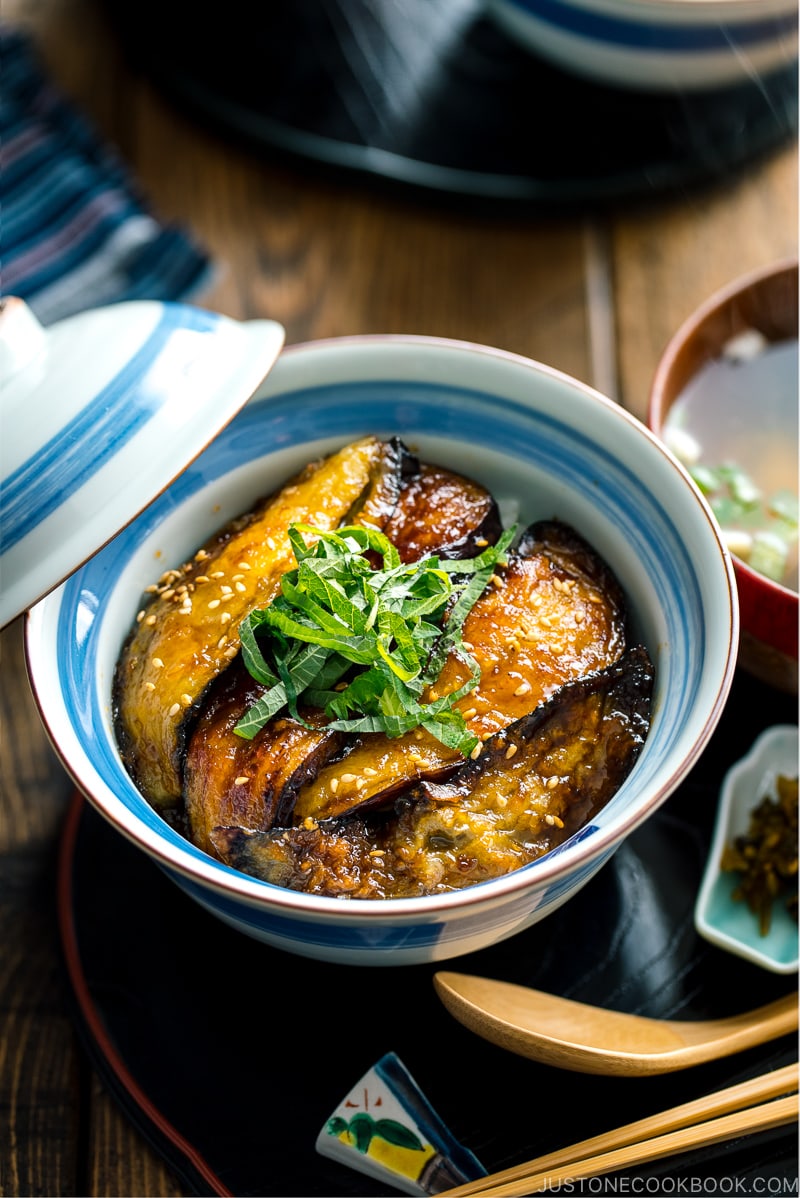
What do you consider a quick meal? For me, anything cooks in one pot or one pan are most ideal. That’s why I often turn to Japanese rice bowls (donburi) when I need something fast and easy-to-assemble. Today’s recipe is Soy Glazed Eggplant Donburi (茄子の甘辛丼), which happens to be plant-based!
Eggplant Rice Bowl – The Most Luxurious Vegan Donburi
Eggplant is undoubtedly the star ingredient that makes the appeal of this rice bowl. Think of it as the tofu of the vegetable world. It is mild and versatile, and it has the ability to take on almost any flavor. What sets eggplant apart from other vegetables is its unique structural integrity, and at the same time, its silky, meaty, and utterly luxurious texture.
That said, it’s very important to cook it right. Here, searing the eggplant until nicely charred delivers the best, deepest flavor. It also renders a buttery tender texture with a crispy edge that is hard to resist. When tossed with a quick sauce of mirin and soy sauce, it makes the most satisfying one-bowl comfort that requires minimal effort.
I could easily cook and eat this eggplant donburi over and over again!
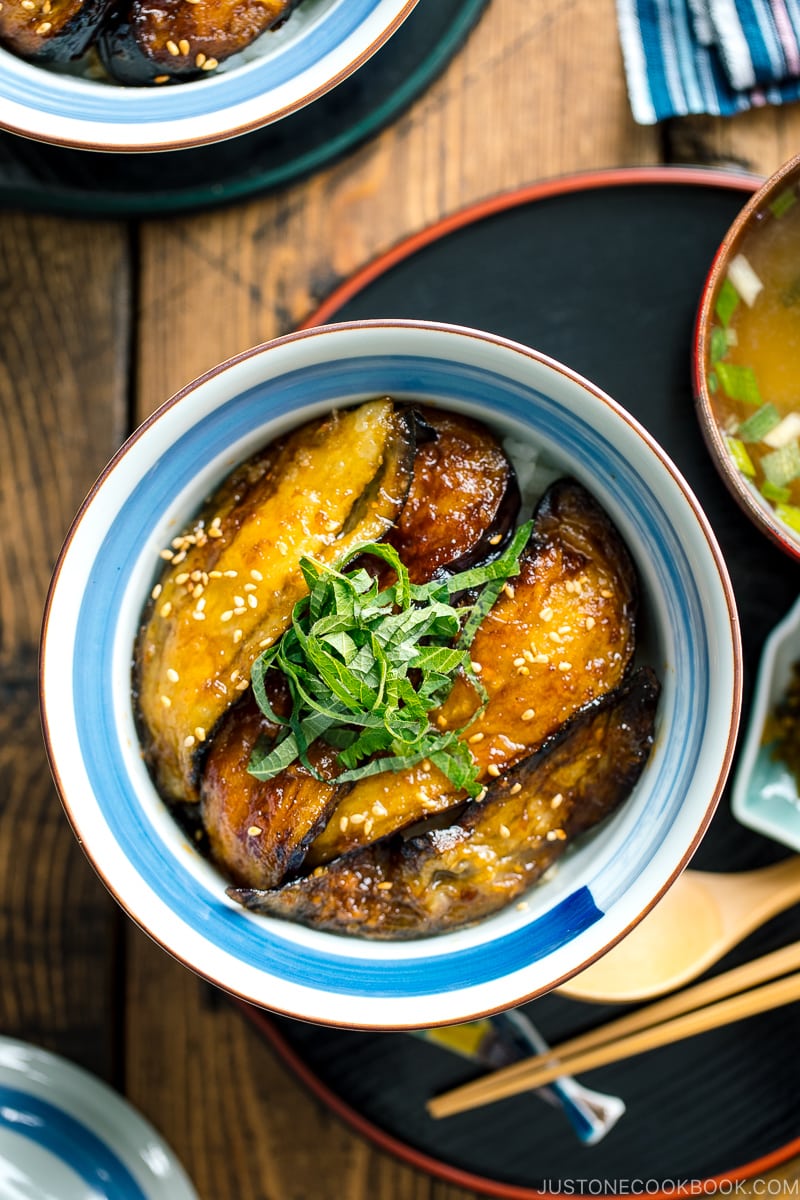
3 Tips to Follow When Cooking the Eggplant
1. Keep the eggplant skin
Eggplant flesh gets tender and soft when it’s cooked through, and if you cook it for too long, the flesh gets mushy. Therefore, it’s very important to:
- Keep the eggplant skin attached to the flesh to maintain its shape.
- Cut the eggplant so the flesh is held by the skin.
For this purpose, I only recommend using Japanese, Chinese, or Italian eggplant. If you use American/glove eggplant, cut into the wedges and use only the part that has skin (and use the middle part for other recipes).
2. Sprinkle salt
Eggplant has soft, spongy flesh with tiny air pockets that acts like a sponge in soaking up oil and liquids. While we like the eggplant to absorb all the good flavors, the challenge is to prevent it from becoming greasy.
The trick to that is by breaking down the air pockets and reducing the sponginess by salting the eggplant first. Salting also prevents the eggplant from discoloring.
Just make sure to wipe off the excess water before frying.
3. Use potato starch/cornstarch
Coating the eggplant with potato starch (or cornstarch) can help:
- Prevents the eggplant from soaking up all the oil.
- Creates a nice golden crust.
- Absorbs all the seasonings.
- Thickens the sauce slightly.
Make sure to remove the excess potato starch and applies only a thin coating.
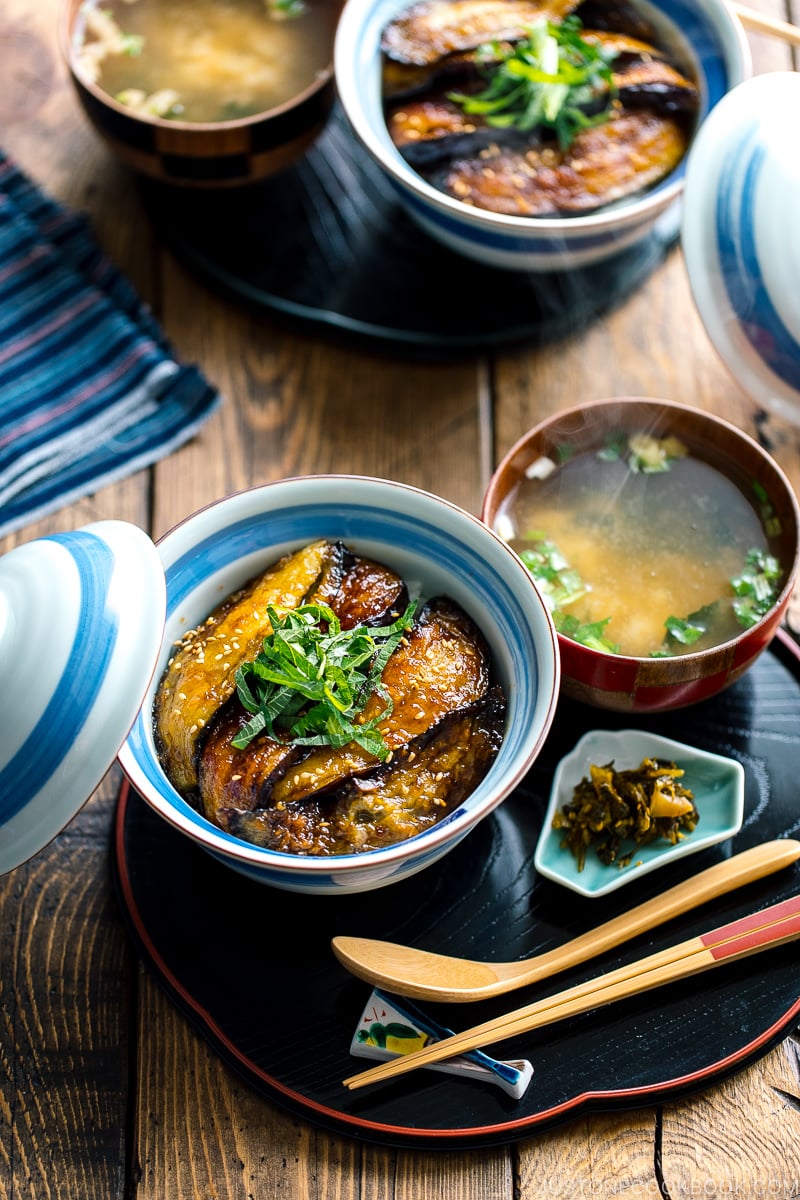
Itadakimasu!
Eggplant skeptics? This Soy-Glazed Eggplant Donburi might change your mind. I hope you give this nightshade vegetable a chance to reveal its deliciousness to you through this recipe. Once tried, you will not get enough of it.
To enjoy this vegan rice bowl, serve it with miso soup and a side of pickle. Here are some of my suggestions:
Other Delicious Vegan Dishes

Wish to learn more about Japanese cooking? Sign up for our free newsletter to receive cooking tips & recipe updates! And stay in touch with me on Facebook, Pinterest, YouTube, and Instagram.

Soy-Glazed Eggplant Donburi
Ingredients
- 2 Japanese or Chinese eggplants (7 oz, 200 g; for a globe eggplant, cut into wedges or rounds with the skin on to hold its shape while cooking)
- ½–1 tsp Diamond Crystal kosher salt (for salting the eggplant)
- 10 shiso leaves (perilla/ooba) (or use 1 green onion)
- 1 tsp ginger (grated, with juice; from 1-inch, 2.5-cm knob)
- 2 Tbsp potato starch or cornstarch
- 4 Tbsp neutral oil (divided)
For the Seasonings
- 4 Tbsp mirin (a fairly close substitute is 4 tsp sugar + 4 Tbsp sake or water; adjust the sweetness to taste; read more about mirin)
- 2 Tbsp soy sauce (or use gluten-free soy sauce for GF)
For Serving
- 2 servings cooked Japanese short-grain rice (typically 1⅔ cups (250 g) per donburi serving)
- ½ tsp toasted white sesame seeds
Instructions
- Before You Start: Gather all the ingredients. For the steamed rice, please note that 1½ cups (300 g, 2 rice cooker cups) of uncooked Japanese short-grain rice yield 4⅓ cups (660 g) of cooked rice, enough for 2 donburi servings (3⅓ cups, 500 g). See how to cook short-grain rice with a rice cooker, pot over the stove, Instant Pot, or donabe.

- Slice 2 Japanese or Chinese eggplants lengthwise into ¼-inch slices. Then, sprinkle with ½–1 tsp Diamond Crystal kosher salt. Set aside for 15 minutes, then wipe off the moisture with a paper towel.

- Rinse 10 shiso leaves (perilla/ooba) and pat dry with a paper towel. Cut off and discard the stems.

- Roll up the shiso leaves and cut them into chiffonade strips.

- Peel the ginger skin and grate the ginger (I use a ceramic grater). Then, measure 1 tsp ginger (grated, with juice) and set aside.

- Put 2 Tbsp potato starch or cornstarch in a small tray. Then, thinly coat both sides of the eggplant slices with the potato starch.

To Cook
- Heat a frying pan over medium heat. When the pan is hot, add 2 Tbsp of the 4 Tbsp neutral oil and distribute it in the pan. Then, add the eggplant slices in a single layer. Cook until the bottom side is golden brown, about 3–4 minutes. Until then, do not touch the eggplants in order to achieve a nice sear.

- When the bottom side is nicely seared, drizzle another 2 Tbsp of the oil on top of the eggplant and flip the slices to cook the other side for an additional 3–4 minutes.

- Once the second side is cooked to a golden brown color, reduce the heat to medium low. Add 4 Tbsp mirin, 2 Tbsp soy sauce, and grated ginger.

- Bring it back to a simmer and spoon the sauce over the eggplant a few times. If the sauce thickens too fast (due to the potato starch), add 1 Tbsp water at a time to loosen it a bit. Remove from the heat when the eggplant is well-coated with the sauce.

To Serve
- In individual donburi bowls (a bit bigger than rice bowls), divide the 2 servings cooked Japanese short-grain rice and drizzle some sauce on top of the rice.

- Then, place the eggplant slices on top. For presentation, I overlap each slice slightly. Garnish on top with ½ tsp toasted white sesame seeds and shiso leaves. Serve immediately.

To Store
- You can keep the leftovers in an airtight container and keep them for 3 days in the refrigerator or for up to a month in the freezer.
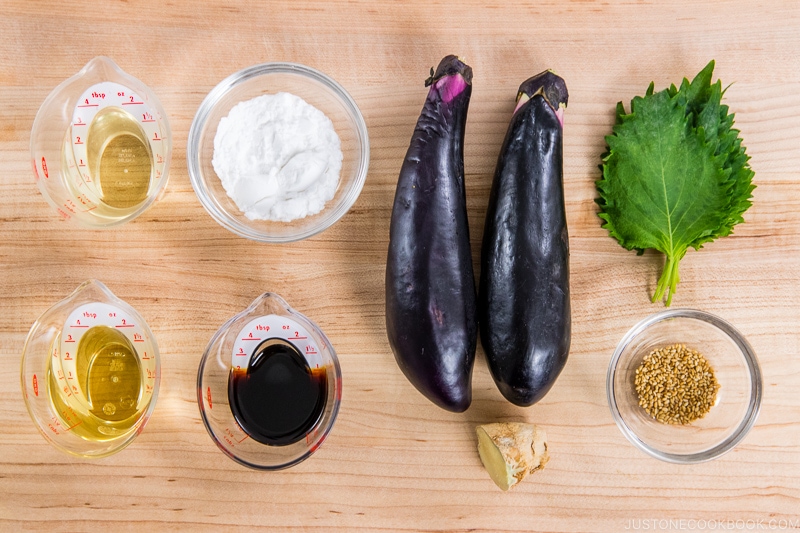
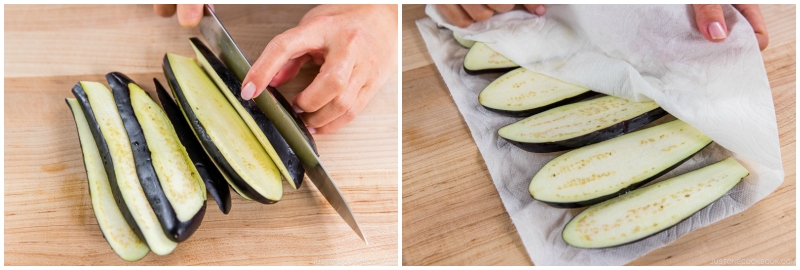
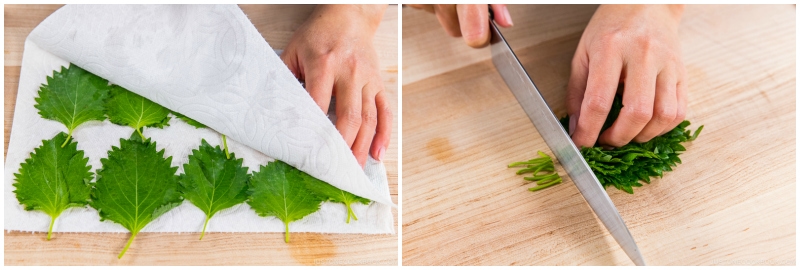
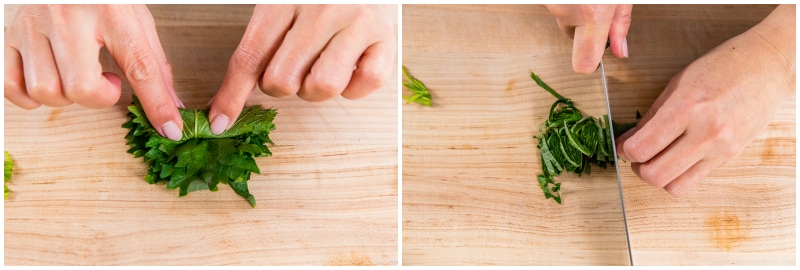
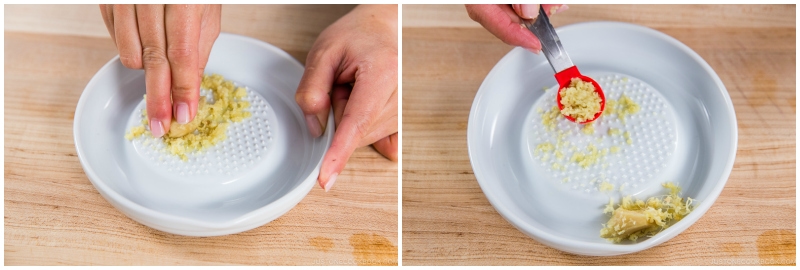
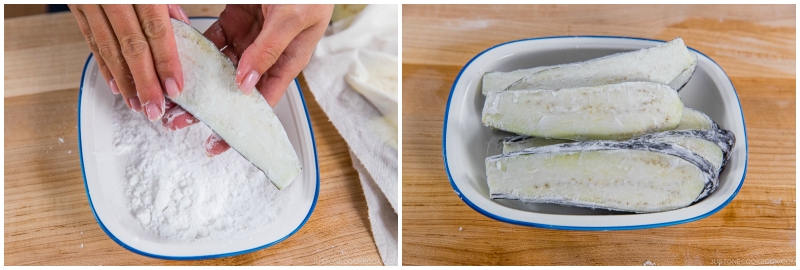
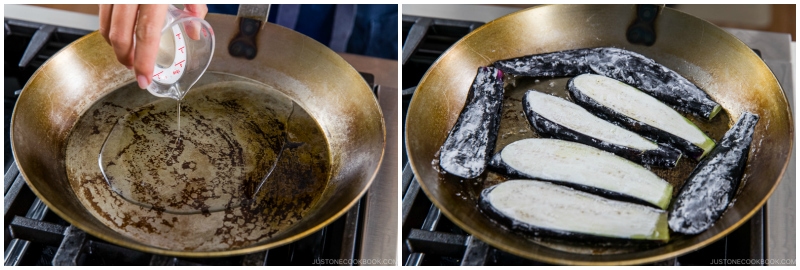
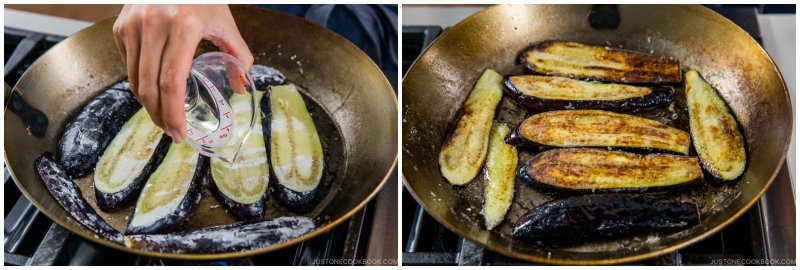
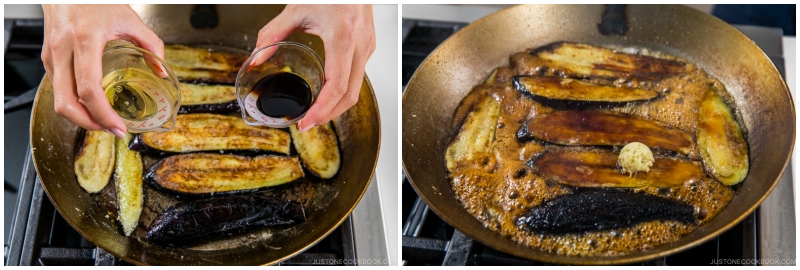
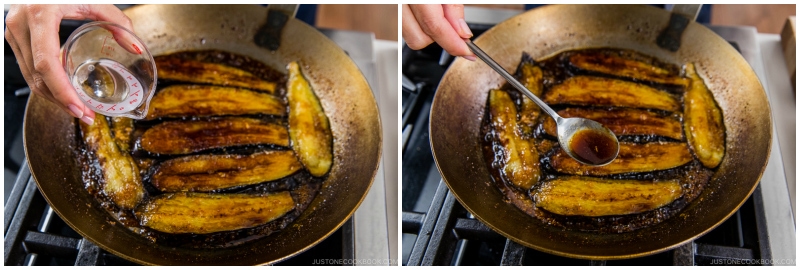
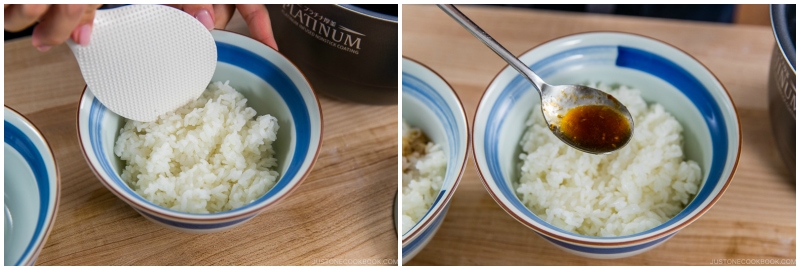
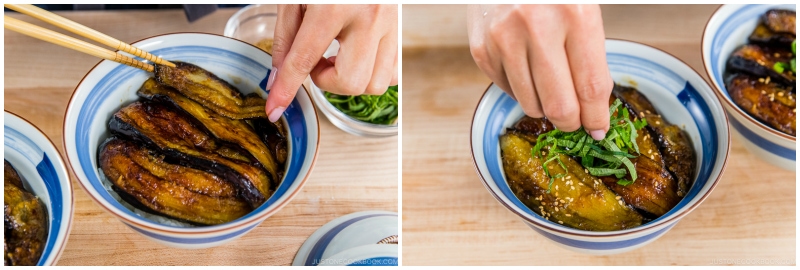










So good! PERfect for a quick hurried meal.
Hello there, Chit! We are glad to know you enjoyed this dish.
Thank you so much for trying Nami’s recipe, as well as for your love and support. 🥰
Excellent!
Hi Chit! Thank you so much for trying Nami’s recipe and for your kind feedback!
Happy Cooking!
I got some thin long ones from my local stores surplus sale and tried this recipe. Store does provide some exotic veggies, but problem tends to be that at normal price people are hesitant to try for example japanese eggplants or similar. Seasoned users are a bit scarse in “rural” Finland. But, others loss, my win, this was “oishii”. Will hunt for nasu after this experience. 🙂
I probably lost some authencity from the taste, as I had to use some dry cider with a little sugar instead of mirin, but as already mentioned it is was still delicious. I cut the eggplant to buttons but probably try the lenghtwise cut next time, and tossed the pieces in potato starch, fried to a beautifull color. I used some leftovers as garnish on butternut squash soup next day, worked great on it, so thumbs up for versatility of the dish.
So, thank you for sharing the recipe.
Hi Mikko! We are glad to hear you enjoyed the dish.
Thank you so much for trying Nami’s recipe and sharing your experience with us. Happy Cooking!☺️
Excellent recipe! Fast and delicious. Surprising GOOD!! Can also be found on page 150 of Just One Cookbook Volume 2. Highly recommended.
Even people who claim not to like eggplant love this dish. If you have leftovers, it goes very well with breakfast eggs and rice.
Hi Bil! Thank you so much for trying Nami’s recipe and providing such positive comments!🥰
We are glad to hear that everyone liked this dish.
Thank you for purchasing Nami’s cookbook as well!
Happy Cooking!
I made this tasty dish for dinner last night, with a side of sunomono. Both dishes are easy to make and not time consuming. As my summer vegetables produce more eggplant, I’ll revisit this recipe.
Hi Bob! Nami and all of us at JOC are so happy to hear you enjoyed the recipes.
Thank you so much for taking the time to read Nami’s post and trying her recipes.
Happy Cooking!
I made this for lunch today for 1, using 1 Japanese eggplant. Was lovely over brown rice. The texture was very soft, and the remainder of the glaze coated my rice nicely. Would recommend as a decently quick and tasty vegetarian option.
Hi somebodycooking, We are so happy to hear you enjoyed Nam’s recipe.☺️
Thank you so much for trying it and sharing your experience with us.
Happy Cooking!
Oh my, this was SO delicious!!!! I literally just ate the whole batch myself and have zero regrets hehe. Eggplant is my absolute favourite and this will be in my regular rotation.
Hi Christine, Thank you so much for trying Nami’s recipe and for your kind feedback!
We are glad to hear that you enjoyed the dish, and this will be in your regular rotation! 🥰 Happy Cooking!
so good and easy and you dont need a ton of ingredients!
Hi gioia, Thank you so much for trying Nami’s recipe!
We are glad to hear you enjoyed the dish.
Happy Cooking!
Hi Nami! I just cooked eggplant for the first time (not the first time I ate it) and I loved it (I normally don’t like it)! It was absolutely sensational! Still have more eggplant and will try your other recipes. Thanks for changing my view on eggplant! I’m now an absolute fan! BTW I just had my first trip to Japan early this month with my bf and it was lovely! I was so fascinated by authentic Japanese cuisine and was living my otaku dream. We came back home and did lots of research on Japanese food so now we are experimenting/trying recipes A LOT! FYI my bf works with edible insects and he has been making cricket tsukudani. After the trip, we started trying to make cricket furikake and it was a delight! (We actually ate it with this eggplant dish tonight). I really can’t wait to have ochazuke with it! Anyways long story short, I also can’t wait to try all of your recipes if I could! We are based in Taiwan and luckily Japanese ingredients are not so difficult to find. I however struggle to perfect cooking short grain rice the Japanese way, still come out bit too wet, unlike the perfect rice we had in Japan. Perhaps the variety here is different, I’ll continue working on this quest! ありがとうございます!
Hello, Linh! Thank you so much for taking the time to read Nami’s post and try her recipes!
Nami and all of us at JOC are so happy you enjoyed eggplant for the first time with Nami’s recipe! It meant so much to us and made us so happy!🥰
We’re also happy to hear you and your boyfriend had a wonderful time in Japan. We hope the trip inspired you and gave you ideas for extending the new dish with edible insects.
As for cooking perfect rice, we recommend checking out Nami’s Rice Recipe. She shared many tips for making perfect rice, so we hope this helps.
https://www.justonecookbook.com/how-to-cook-rice/
Thank you for sharing your story and providing such thoughtful feedback. Happy cooking!
Just want to say thank you! didn’t have mirin but I had teriyaki so I substituted that. I made this to make Eggplant onigiri and it was fantastic! Thank you so much! would never have thought to make eggplant this way.
Hi Jordan, Thank you so much for trying Nami’s recipe and for your kind feedback!
We are glad to hear you enjoyed this dish. Eggplant Onigiri sounds so good too.
Happy Cooking!